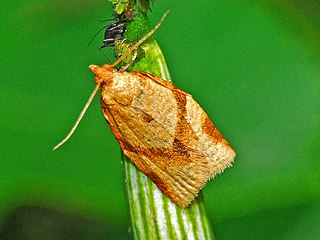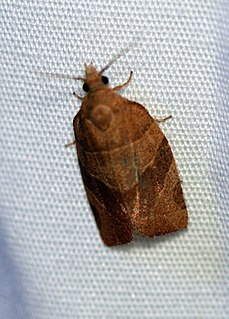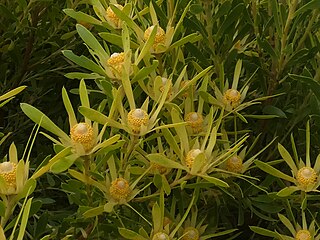
The stoat or short-tailed weasel, also known as the ermine, is a mustelid native to Eurasia and North America. Because of its wide circumpolar distribution, it is listed as Least Concern on the IUCN Red List.

Atypidae, also known as atypical tarantulas or purseweb spiders, is a spider family containing only three genera. They are accomplished ambush predators that spend most of their time in a sock-like, silken retreat on the ground from where they kill their prey.

Pandemis cerasana, the barred fruit-tree tortrix, is a moth of the family Tortricidae.

Pandemis heparana, the dark fruit-tree tortrix or apple brown tortrix, is a moth of the family Tortricidae.

Hakea epiglottis is a shrub commonly known as beaked hakea or needlebush hakea and is endemic to Tasmania where populations consist of functional unisexual plants. In a 1989 publication by John Wrigley & Murray Fagg states specimens at Wakehurst Place, an annexe of Kew Gardens London are specimens believed to be 60-70 years old measuring 3 m (9.8 ft) high and wide.

Pandemis is a genus of moths of the family Tortricidae and the tribe Archipini.

Moniliformidae is a family of parasitic spiny-headed worms. It is the only family in the Moniliformida order and contains three genera: Australiformis containing a single species, Moniliformis containing eighteen species and Promoniliformis containing a single species. Genetic analysis have determined that the clade is monophyletic despite being distributed globally. These worms primarily parasitize mammals, including humans in the case of Moniliformis moniliformis, and occasionally birds by attaching themselves into the intestinal wall using their hook-covered proboscis. The intermediate hosts are mostly cockroaches. The distinguishing features of this order among archiacanthocephalans is the presence of a cylindrical proboscis with long rows of hooks with posteriorly directed roots and proboscis retractor muscles that pierce both the posterior and ventral end or just posterior end of the receptacle. Infestation with Monoliformida species can cause moniliformiasis, an intestinal condition characterized as causing lesions, intestinal distension, perforated ulcers, enteritis, gastritis, crypt hypertrophy, goblet cell hyperplasia, and blockages.

Clepsis consimilana, the privet tortrix, is a moth of the family Tortricidae.

Pandemis corylana, the chequered fruit-tree tortrix, hazel tortrix moth, filbert tortricid or barred fruit tree moth, is a moth of the family Tortricidae. It is found from northern and central Europe to Siberia, Korea and Japan.
Pandemis ianus is a moth of the family Tortricidae. It is found in north Madagascar.
Pandemis chondrillana is a species of moth of the family Tortricidae. It is found in France, Bulgaria, Romania, Ukraine, Russia, Asia Minor, Iran, Afghanistan, from Kazakhstan to Siberia, Kyrgyzstan, Mongolia and north-western China.
Pandemis acumipenita is a species of moth of the family Tortricidae. It is found in Sichuan, China.

Pandemis dumetana is a species of moth of the family Tortricidae. It is found in China, South Korea, Japan, Russia, northern India, almost all of Europe, Asia Minor, Iran, southern Siberia and Transcaucasia. The habitat consists of woodlands, fruit farms, orchards and gardens.

Pandemis limitata, the three-lined leafroller, is a species of moth of the family Tortricidae. It is found in North America, where it has been recorded from Nova Scotia to British Columbia and from the east coast west to the Rocky Mountains and Arizona. It has also been recorded from Durango in Mexico.
Pandemis piceocola is a species of moth of the family Tortricidae. It is found in China (Gansu).
Pandemis pyrusana, the apple pandemis or pandemis leafroller moth, is a species of moth of the family Tortricidae. The species was first described by William D. Kearfott in 1907. It is found in North America, where it has been recorded from Alberta to British Columbia, south through Idaho, Utah and Colorado and California. The habitat consists of forests with deciduous trees and shrubs.

Pandemis lamprosana, the woodgrain leafroller moth, is a species of moth of the family Tortricidae. It is found in North America, where it has been recorded from the north-eastern United States, Quebec and Ontario.
Pandemis ignescana is a species of moth of the family Tortricidae. It is found in the Russian Far East and Japan.

Leucadendron salignum, also known as the common sunshine conebush, is an evergreen, dioecious shrub that produces several stems from the ground of up to 2 metres high; forming part of the genus Leucadendron from the family Proteaceae. It survives the wildfires that occur every one or two decades in the fynbos where it occurs by regrowing from an underground rootstock. Pollinated by beetles, it flowers from April to November. The winged seeds remain in the woody cones until they are released after a fire, and are distributed by the wind. It is possibly the most common Proteaceae species in South Africa, and can be found in the Northern Cape, Western Cape and Eastern Cape provinces. Its current conservation status is Least Concern.

Leucadendron coniferum, also known at the dune conebush, is an evergreen, dioecious shrub or small tree of up to 4 m (13 ft) high, that has been assigned to the family Proteaceae. It has a whorl of conspicuous yellow leaves subtending the flowerheads. The flowers can be found in August and September. It grows in sandy soils near the coast of the Western Cape province of South Africa.













